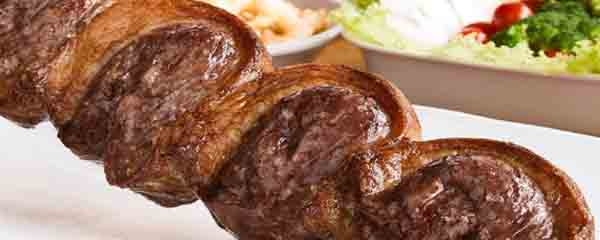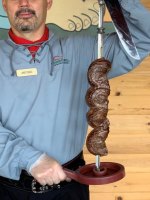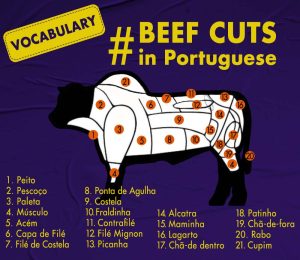Blog
Brazilian BBQ: All You Need to Know About Brazilian Barbecue, Beef Cuts & Rodízios
- Thursday May 26th, 2022
- Posted by: Amanda Ennes
- Category: Brazil

Brazilian BBQ is not only about food. Instead, it is a cultural event that revolves around friends, family, music, drinks, and lots of meat. It is very common for Brazilians to gather on the weekends for a homemade barbecue event with friends and family.
However, we also have steakhouses — restaurants that serve the traditional Brazilian barbecue. These Brazilian steakhouses usually work as Rodízio, an all-you-can-eat style of restaurant service.
Brazilian beef cuts are also famous for their quality and juiciness. In this blog post, you will learn all about Brazilian BBQ, the steakhouses, and the characteristics of each cut.
Table of Contents
ToggleBrazilian Steakhouses – Churrascaria Rodízio
 Most steakhouses in Brazil are all-you-can-eat style. You pay a fixed price and waiters bring different cuts of meat to you every other minute throughout the meal. You can ask for a slice of the meat offered or pass. Side dishes are also included in the price, such as french fries, farofa, grilled plantains, fried manioc, and much more. Waiters will also bring these side dishes to you.
Most steakhouses in Brazil are all-you-can-eat style. You pay a fixed price and waiters bring different cuts of meat to you every other minute throughout the meal. You can ask for a slice of the meat offered or pass. Side dishes are also included in the price, such as french fries, farofa, grilled plantains, fried manioc, and much more. Waiters will also bring these side dishes to you.
Furthermore, cuts of chicken, pork and special meat such as lamb and boar are also available. And if you think that is all, just wait for it — most steakhouses also offer free buffet stations with salad, cheese, seafood, and other side dishes.
Basically, you only need to pay for drinks, dessert, and tips on top of the fixed Rodízio price.
Brazilian BBQ
 Brazilians use a traditional barbecue station to grill their meat. It is made of brick with a long chimney. It is almost a rule in Brazil: if you have a backyard, you must have one of those. Also, barbecue charcoal is the main method to heat the grill, while gas BBQ stations are not that popular in Brazil.
Brazilians use a traditional barbecue station to grill their meat. It is made of brick with a long chimney. It is almost a rule in Brazil: if you have a backyard, you must have one of those. Also, barbecue charcoal is the main method to heat the grill, while gas BBQ stations are not that popular in Brazil.
The beef is cooked on a long skewer over an open flame. Each cut roasts slowly on the skewers until the outer layer is seared and the inside is tender and juicy. You serve the meat by cutting off slices of it.
Moreover, most Brazilians only use salt to season their barbecue. However, we are not talking about table salt, but natural rock salt. Its texture and flavor accentuate the flavor of the meat.
Beef Production in Brazil
Brazil is the largest exporter of beef in the world. Australia and the United States come after, respectively. The country has China and Hong Kong as its main destinations for beef exports. Currently, the beef cattle population in Brazil is around 200 million, and we export the meat to over 100 different countries.
So, why is Brazilian meat so popular? The Nelore breed is responsible for 80% of beef production in Brazil. Still, another Brazilian breed stands out for its high-quality meat. Around the 18th century, Zebu-type cattle were brought from India to Brazil and crossed with the Charolais species from France. This cross generated a type of cattle called Canchim, adapted to our pasture and climate conditions. Working with different species, Brazilian cattle also had to adapt to cuts for consumption. Because of that, Picanha is such a popular beef cut, famous for its Brazilian origins.
Brazilian Beef Cuts

- Peito: Good for roasting.
- Pescoço: Ideal for slow-cooking.
- Paleta: It is juicy and tender, good for pot roasts, stews, and cut into cubes.
- Músculo: Perfect to make soup and broths.
- Acém: Lean type of meat, used for sautéeing, roasting, ground, or steak.
- Capa de filé: It has high quantities of connective tissues and requires longer cooking. Good for roasts and stews.
- Filé de costela: Used in stir-fries and pot stews.
- Ponta de agulha: It needs to be cooked for longer, preferably in a pressure cooker.
- Costela: Juicy meat with high amounts of fat — good for a Brazilian BBQ or stew.
- Fraldinha: It is juicy and tender, used for barbecuing, pot roasts, and local recipes.
- Contrafilé: This is a juicy, tender, and low-fat prime meat.
- Filé mignon: Prime meat used for steaks.
- Picanha: Famous Brazilian beef cut, it is the most requested meat in Brazilian steakhouses and homemade BBQs.
- Alcatra: Also a prime beef, although not as expensive as Picanha. It is good for barbecues, as well as steaks.
- Maminha: It lies whitin Alcatra. It is popular for its tenderness and juiciness.
- Lagarto: Even though it is considered prime meat, it is dry and not very juicy. Good for roasting after cooking it in a pressure cooker.
- Chã de dentro: Ideal for roasts, stews, scallops, steak, steak rolls, or ground beef.
- Patinho: Lean meat with soft fibers. Good to make steaks, stews, and ground beef.
- Chã de fora: It needs to be cooked slowly. Used for stews, pot roasts, and roast beef.
- Rabo: Used in a Brazilian recipe called Rabada, usually served with potatoes and watercress.
- Cupim: Famous for its fat content, giving it flavor and tenderness. It is among the most popular choices in Brazilian BBQs.
Caminhos Language Centre is the largest and most exciting Portuguese school in Rio de Janeiro, Brazil. We have an excellent infrastructure, over 15 experienced Brazilian teachers, and a friendly multilingual support staff. We are the only school in Brazil able to offer Portuguese group courses throughout the year on 10 different levels. Moreover, our school also offers more than just Portuguese lessons for foreigners, we offer you the complete Rio de Janeiro experience. Every day we organize 100% free and fun activities for you to socialize and practice your Portuguese. We can also help you with a student visa for Brazil and accommodation in Rio de Janeiro.


 Deutsch
Deutsch Français
Français Português
Português Español
Español
